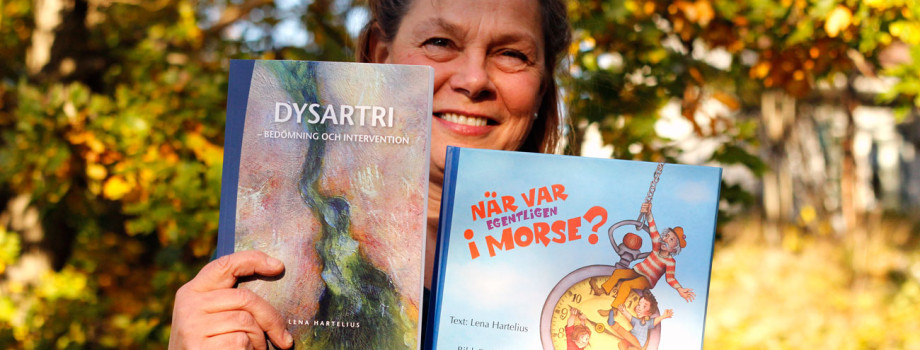PUBLICATION. This fall no less than two books by Lena Hartelius have been released. The first is a Swedish textbook on dysarthria, a speech disorder that is common after a stroke or other neurological disease. The other is a children’s book about time.
It took almost ten years for Lena Hartelius, Professor of Speech and Language Pathology to finish the book on dysarthria. It is published by Studentlitteratur and will be soon be available from the printer. It is both a textbook and an assessment and evaluation guide for a motor speech disorder that commonly occurs as a result of a neurological disease and stroke.
“The assessment and evaluation guide presented in the book is a revision of a test that was given out in the early 90s, but that has not been available for many years. We even used the revised test on a hundred healthy persons to obtain reference material,” says Lena Hartelius.
The book will be used in the Speech and Language Pathology Program at Sahlgrenska Academy and other universities, and is also intended for speech and language therapists specializing in neurological diseases. Together with colleagues at the Division for Speech and Language Pathology at the Karolinska Institute and the Mayo Clinic in Rochester, Minnesota, Lena Hartelius has also given commissioned programs in Gothenburg and Stockholm to promote a unified method for assessing patients with dysarthria and top spread the revised test.
“I hope the book and the test can help make persons with dysarthria visible. Patients who have difficulty expressing themselves are often improperly treated and not given the necessary attention for optimal care,” says Lena Hartelius.
Publishing two books during one month is pretty surreal, explains Lena Hartelius,
“It’s a bit like a twin birth, fraternal twins. They are two very different books.
The children’s book, När var egentligen i morse? (When Was this Morning Really?), is about four-year-old Karl and Arvid who discuss time with their grandfather. Lena Hartelius got the idea for the book several years ago, when she had trouble understanding a four-year-old’s story, until she understood that the child used the concept this morning for all time in the past. After taking a writing course, she was inspired to make it happen – she took a week’s vacation to get started and write the children’s book.
Much later by chance, she acquired a list of smaller publishing companies that publish children’s books; submitted her manuscript to ten of them, and was accepted by Vombat publishers.
“They are a publisher who understands what a child’s reality is like. They were careful to ensure that the book could play out anywhere when they worked with the book’s illustrator, and they changed the ethnicity of one of the characters in the book,” says Lena Hartelius, who is extremely happy that it was just this publisher who chose to publish her children’s book.
She has received many positive reactions from colleagues at the Division for Speech and Language Pathology, for both of her books. Personally, she believes it is valuable to change what you do at some point and do something completely different from what you normally work with,
“It is enriching to try something new. Moreover, it increases your creativity and energy in your work.”











